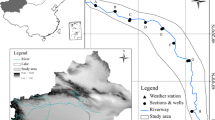Abstract
Lake-side wetlands and their original vegetation have become rare in The Netherlands. The few remaining lake-side wetlands (also called: boezemlands) are mostly managed as nature reserves. Much attention is given to the preservation and restoration of species-rich meadows (Calthion palustris). In lake-side wetlands, both desiccation and acidification endanger the characteristic environmental conditions of these plant communities.
The aim of this study was to develop guidelines for water management in different types of boezemlands. Three sites, representing different hydrological conditions, were selected. The steady-state groundwater model FLOWNET was used to describe water movement. The results of vegetation surveys were used to produce response curves for important species, giving correlations between their presence and environmental conditions (groundwater levels, soil pH).
Three types of lake-side wetlands (boezemlands) can be distinguished, with different hydrology and management:
-
a. Original boezemlands which have free drainage to a lake.
-
b. Summer polders which are artificially drained in summer and inundated in winter.
-
c. Winter polders which are artificially drained throughout the whole year.
Measures to counter the effects of desiccation and acidification and to improve the prospects for Calthion palustris are proposed:
-
a. Measures are required to guarantee sufficient infiltration with water from the lake in the original boezemlands.
-
b. The same measures are needed to prevent desiccation in summer polders. Furthermore, it has to be ensured that inundation takes place with base-rich water from the lake. In this way the proportion of water derived from precipitation is limited and acidification is minimized.
-
c. Extra intake of base-rich boezemwater is required during dry periods in winter polders, that can be achieved through a dense network of ditches.
Similar content being viewed by others
References
Al-Mufti, M.M., Sydes, C.L., Furness, S.B., Grime, J.P. and Band, S.R. 1977. A quantitative analysis of shoot phenology and dominance in herbaceous vegetation. J. Ecology, 65: 759–791.
Boyer, M.L.H. and Wheeler, B.D. 1989. Vegetation patterns in spring-fed calcareous fens: calcite precipitation and constraints on fertility. J. Ecology, 77: 597–609.
Evens, F.J. and De Vries, N.P.J. 1991. De Vegetatieontwikkeling van Beekdalsystemen. Historische Uitgeverij, Groningen.
Fiselier, J., Klijn, F., Duel, H. and Kwakernaak, C. 1992. The choice between desiccation of wetlands or the spread of Rhine water over the Netherlands. Wetland Ecology and Management, 2: 85–93.
Fresco, L.F.M. 1991. Vegrow. Processing of vegetation data. Shorthand manual v. 4.0 S-BEES, Haren.
Grime, J.P., 1979. Plant strategies and Vegetation. Wiley, Chicester.
Grootjans, A.P., Schipper, P.C. and Van der Windt, H.J. 1985. Influence of drainage on N-mineralization and vegetation response in wet meadows. I. Calthion palustris stands. Acta Oecologica/Oecologica Plantarum, 6: 403–417.
Grootjans, A.P. and Ten Klooster, W.P. 1980. Changes of groundwater regime in wet meadows. Acta Bot. Neerl., 29: 541–554.
Huisman, J., Olff, H. and Fresco, L.F.M. 1993. A hierarchical set of model for species response analysis. J. Vegetation Science 4: 47–56.
Jeglum, J.K. 1971. Plant indicators of pH and water level in peatland at Candle lake Saskatchewan. Canadian J. Botany, 49: 1661–1676.
Kemmers, R.H. 1986a. Perspectives in modeling of processes in the root zone of spontaneous vegetation at wet and damp sites in relation to regional water management. In: Hooghart, J.C. (ed.) Water Management in Relation to Nature, Forestry and Landscape Management. pp. 91–116. CHO-TNO Proc. and Inf. 34, The Hague, The Netherlands.
Kemmers, R.H. 1986b. Calcium as a hydrological characteristic for ecological states. Ecology (CSSR), 5: 271–282.
Luthin, J.W. and Kirkham, D. 1949. A piezometer method for measuring the permeability of the soil in situ below the water table. Soil Science, 68: 349–358.
Niemann, E. 1963. Beziehungen zwischen Vegetation und Grundwasser. Archiv für Naturschutz and Landschaftsforschung, 3, 1: 3–37.
Snowden Cook, R.E.D. and Wheeler, B.D. 1993. Iron toxicity to fen plant species. J. Ecology, 81: 35–46.
Tilman, D. 1982. Resource Competition and Community Structure. Princeton Univ. Press, Princeton.
Van Dam, H. and Beltman, B. 1992. Effects of climatic change on chemistry and vegetation of peatlands, with special reference to interaction with atmospheric deposition. Wetland Ecology and Management, 2: 69–83.
Van Diggelen, R., Grootjans, A.P., Wierda, A., Burkunk, R. and Hoogendoorn, J. 1991. Predictions of vegetation changes under different hydrological scenarios. In: Nachtnebel, H.P. and Kovar, K. (eds), Hydrological Basis of Ecologically Sound Management of Soil and Groundwater. Proc. Vienna Symp. Aug 1991. pp. 71–80, IAHS Publ. No. 202.
Van Diggelen, R., Grootjans A.P. and Burkunk, R. 1994. Assessing restoration perspectives of disturbed brook valleys: the Gorecht area, The Netherlands. Restoration Ecology 2: 87–96.
Van Elburg, H. and Engelen, G.B. 1986. Two-dimensional finite difference modeling of groundwater flow systems on micro and personal computers. In: Engelen, G.B. and Jones, G.P. (eds.), Developments in the Analysis of Groundwater Flow Systems. Publ. 163, IAHS, Wallingford, England.
Van Wirdum, G. 1991. Interface theory and the base state of fen mires. In: Nachtnebel, H.P. and Kovar, K. (eds), Hydrological Basis of Ecologically Sound Management of Soil and Groundwater. Proc. Vienna Symp. Aug 1991. pp. 173–186, IAHS Publ. No. 202.
Wierda, A., Fresco, L.F.M. and Grootjans, A.P. in press., Numerical assessment of plant species as indicators of groundwater regime. J. Veg. Sci.
Author information
Authors and Affiliations
Rights and permissions
About this article
Cite this article
Spieksma, J.F.M., Schouwenaars, J.M. & van Diggelen, R. Assessing the impact of water management options upon vegetation development in drained lake side wetlands. Wetlands Ecol Manage 3, 249–262 (1995). https://doi.org/10.1007/BF00179840
Issue Date:
DOI: https://doi.org/10.1007/BF00179840




